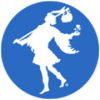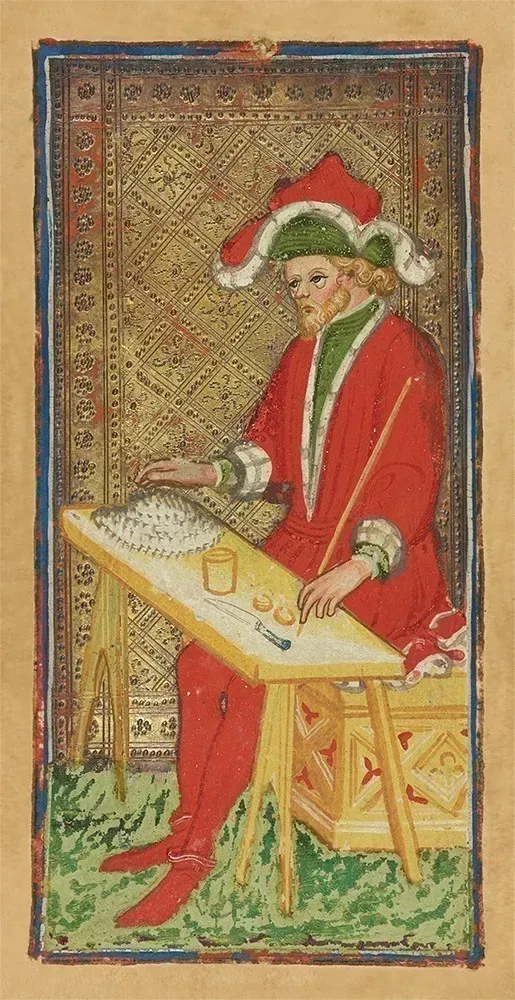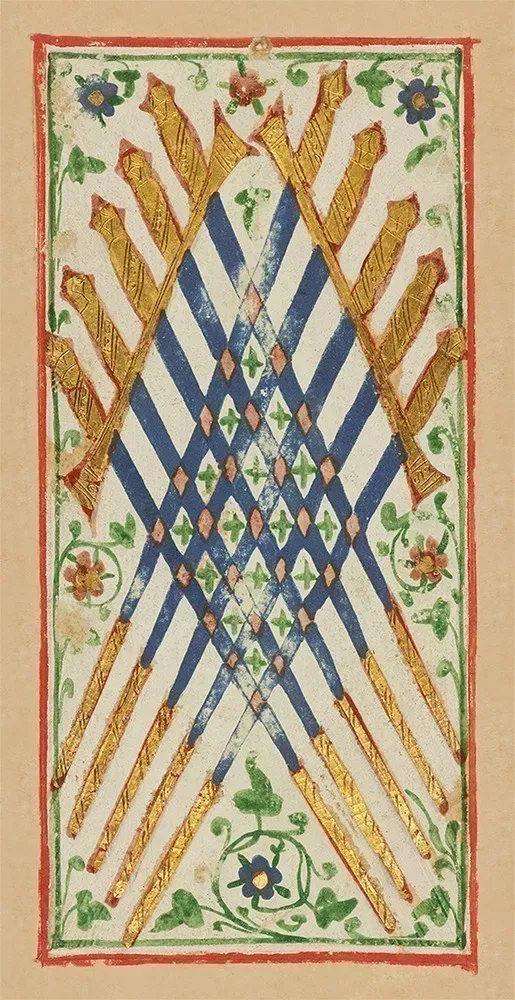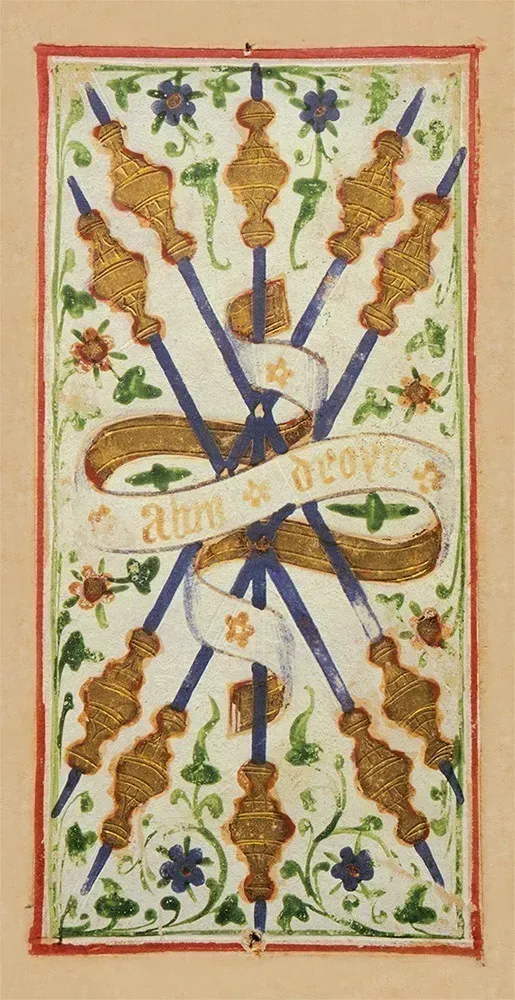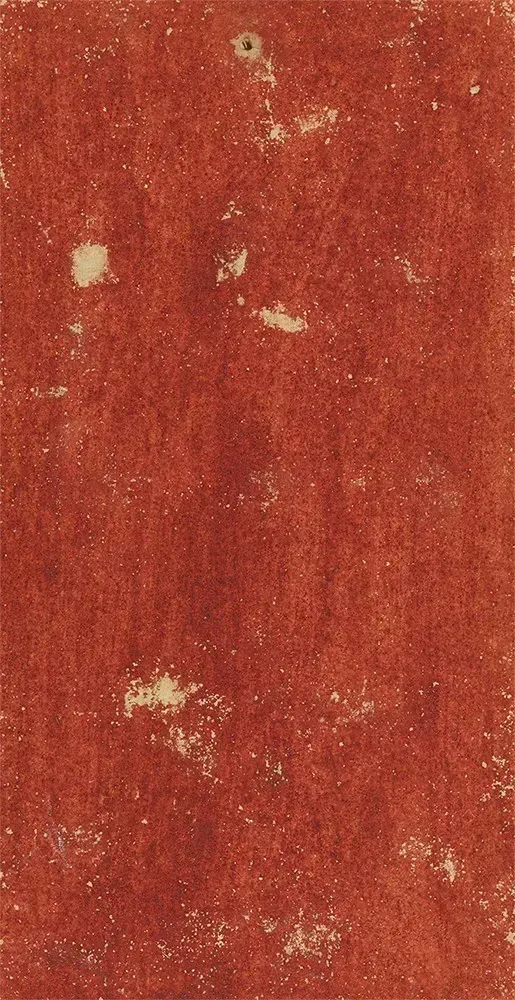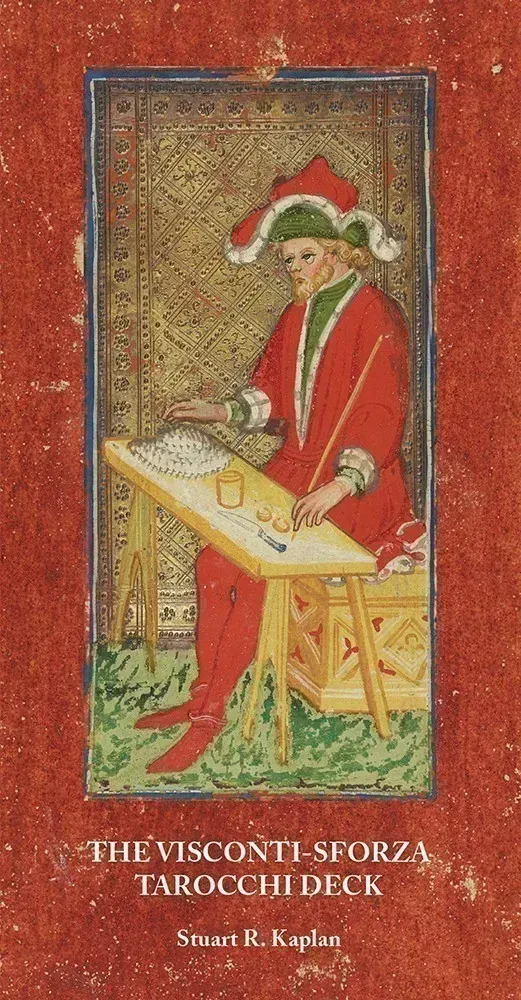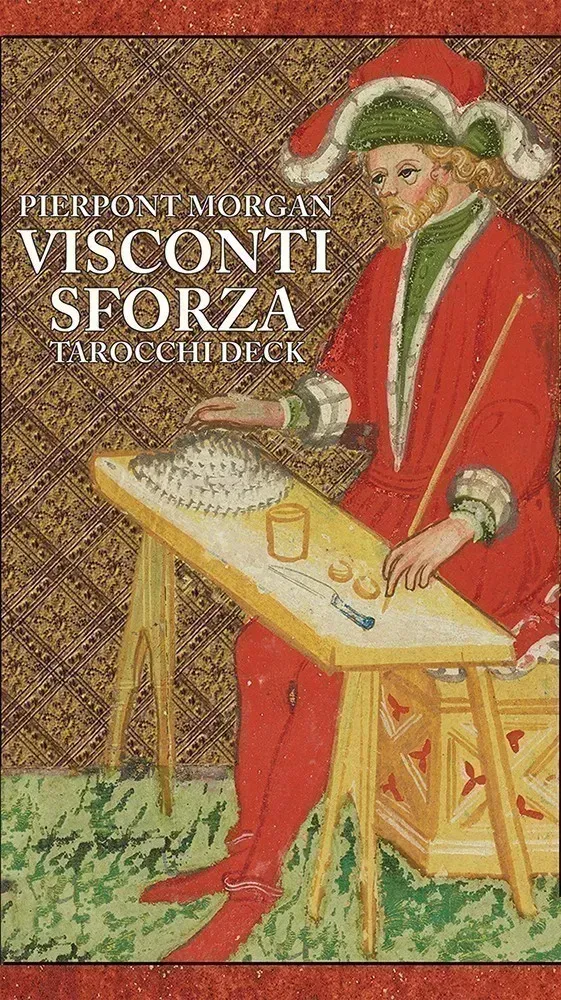
This new edition presents an 80-card deck with expanded guidebook in a deluxe, hinged box. The 60-page guidebook, by Stuart R. Kaplan, features color illustrations of the tarocchi cards. The pack includes two bonus cards with portraits of Bianca Maria Visconti and Francesco Sforza. The 78-card deck is comprised of full-color facsimile reproductions of 74 extant, original Visconti-Sforza tarocchi cards that have survived from the 15th century (Milan, Italy). Four cards have been meticulously recreated to replace those missing from the original deck; The Devil, The Tower, Three of Swords, and Knight of Coins. The cards, which do not have titles or numbering, depict daily life in medieval Milan through allegorical imagery.
The original cards are located in three different locations. Thirty-five of the original cards are located in the archives of the Pierpont Morgan Library in New York. Twenty-six extant cards are at the Accademia Carrara in Italy, and thirteen cards are housed at Casa Colleoni, in Bergamo, Italy.
-
ISBN978-0-91386-606-1
-
SizeCards measure 3.625" x 6.875" Box measures 4"x 7.25"
-
LanguageEN
What Customers Are Saying About Visconti-Sforza Pierpont Morgan Tarocchi Deck
The Visconti-Sforza Pierpont Morgan truly sets the standards and the origin of the past and present tarot cards. These cards were the first "official" tarot card deck made, and it sets the standard and the original look of our modern decks. They were made NOT for divination or mystical goals, but for simple gambling. These beautiful cards are larger than the size of our modern tarot, simply because the medieval necessity of fancy decorations surrounded that weighs more than convenient shuffling. A hole has been punched in all cards, and two of the cards (Tower and Devil) were added in the modern reproduction. However, it is quite possible that both missing cards were never there in the first place, due to the religious and political controversy that surrounds these gambling cards. By taking historically comparing these late 15th century cards to modern cards, one is able to appreciate the beauty and changes in detail that has been embedded in many of our modern tarot cards. Such as the Fool, that later tarot decks added a sun; the Hermit, has been replaced from holding an hourglass to a lantern; Coins became the Neo-Pagan pentacles; batons served as magical wands. Temperance was originally a female pouring water from one vase to another, yet became a nude female pouring waters to both sea and land in modern decks, and so on.
The cards have no titles, no numerical alphabetical allegories (since Comte De Mellet first established the infamous 22 Hebrew letters to the tarot, not Eliphas Levi), which makes their outlook more authentic, yet may be more complicated for a tarot beginner. Their background is a simple reddish brown/maroon color, and they must be shuffled from the sides rather than the top for convenience. In my opinion, these are the "true" and original tarot that many of us may be looking for. They set the standards and values to modern tarot decks and their designs.
—Lloyd R. Belthazar, Aeclectic Tarot
The artwork is very dark and medieval, but quite lovely. Labeled as extraordinary examples of renaissance art, this is much more than a deck of cards.
It's all in the details as the backgrounds of the Court Cards, and the cards in the Major Arcana are all of the same dark colored backing with a gold repeating stamp. When the actual deck is viewed under normal lighting conditions the backgrounds of these cards take on the appearance of gold leaf.
The imagery on the Majors and Courts all have a very surreal three dimensional look that will have you rubbing your finger across them. All 78 cards, including the Pips, have some element of relief, or raised, aspect to them.
There is some of the symbolism here that is present in the Rider/Waite/Smith deck, but only in the Major Arcana and Court Cards. The Minor Arcana are quite spartan, featuring only the number of items from the chosen suit, i.e. six Cups, eight Swords, etc. Justice XI and Strength VIII are reversed in order, becoming Justice VIII and Strength XI.
—Richard and Jennifer Shadowbox, Shadowfox Tarot
The "Visconti Sforza - Pierpont Morgan" deck is a reproduction, in authentic color tones, from the most nearly complete existing Visconti-Sforza tarocchi deck, dating from mid-fifteenth century Milan. I found this to be an astounding deck, and one that I automatically viewed with reverence. To "see" the history that the Tarot world so delights in discussing takes it out of the realm of discussion and into the realm of reality. It is an "Aha!" experience of unimaginable magnitude.
The LWB (Little White Book) that accompanies this deck is interesting in and of itself, as it is formatted to match the size of the cards - which are outsized, long and narrow. In his introduction, Stuart Kaplan gives a short synopsis of Tarot history in Italy from the mid-sixteenth century. Included in the explanations for the Major Arcana, suits and Court cards are charts showing the card/suit title in English, French and Italian, as well as the established number sequence (with the Fool being unnumbered, Justice as VIII and Strength as XI), and playing card correspondences for the suits.
One part of the LWB that I found to be unique, and quite informative, was the section on the Visconti and Sforza family heraldic devices, which included information on the two families. The five devices discussed for the Visconti family are the bird, the ducal crown, the sun, the black eagle and the motto; the two devices discussed for the Sforza family are the lion and three interlocking diamond rings.
There is also a table that lists where existing cards from the Visconti and Visconti-Sforza decks are located (i.e. which library or museum they are in). A short background on possible artists for this deck is included, along with comments on the dating of the Visconti-Sforza decks. Each card is presented with a small black and white scan, a discussion of the card (including a discussion of elements within the card), upright and reversed divinatory meanings.
I found the Major Arcana to be of most interest in this deck, as they represent one of the first Tarot decks ever produced. From these cards we can see where the changes came on through the years. Here we see the Fool facing us directly, without his purse and faithful companion. The Magician we see seated before his table, the High Priestess is seated, book in hand, but there are no pillars. The Empress shows the a seated figure with a shield in one hand, the Emperor holds a globe in his left hand and a scepter in his right hand. The Hierophant is a solo figure, with his right hand raised to give the sign of the blessing. The Lovers shows a male and a female figure, with a blindfolded, winged Cupid above them.
For anyone wanting to understand the history of Tarot, or interested in the art background of early Tarot decks, this is a must have deck. The LWB that accompanies the deck provides an incredible amount of information in a very small amount of space. For this we all owe a debt of gratitude to Stuart Kaplan. This is a deck that lends itself to readings, journeying, meditation and ritual work.
—Bonnie Cehovet, Aeclectic Tarot

